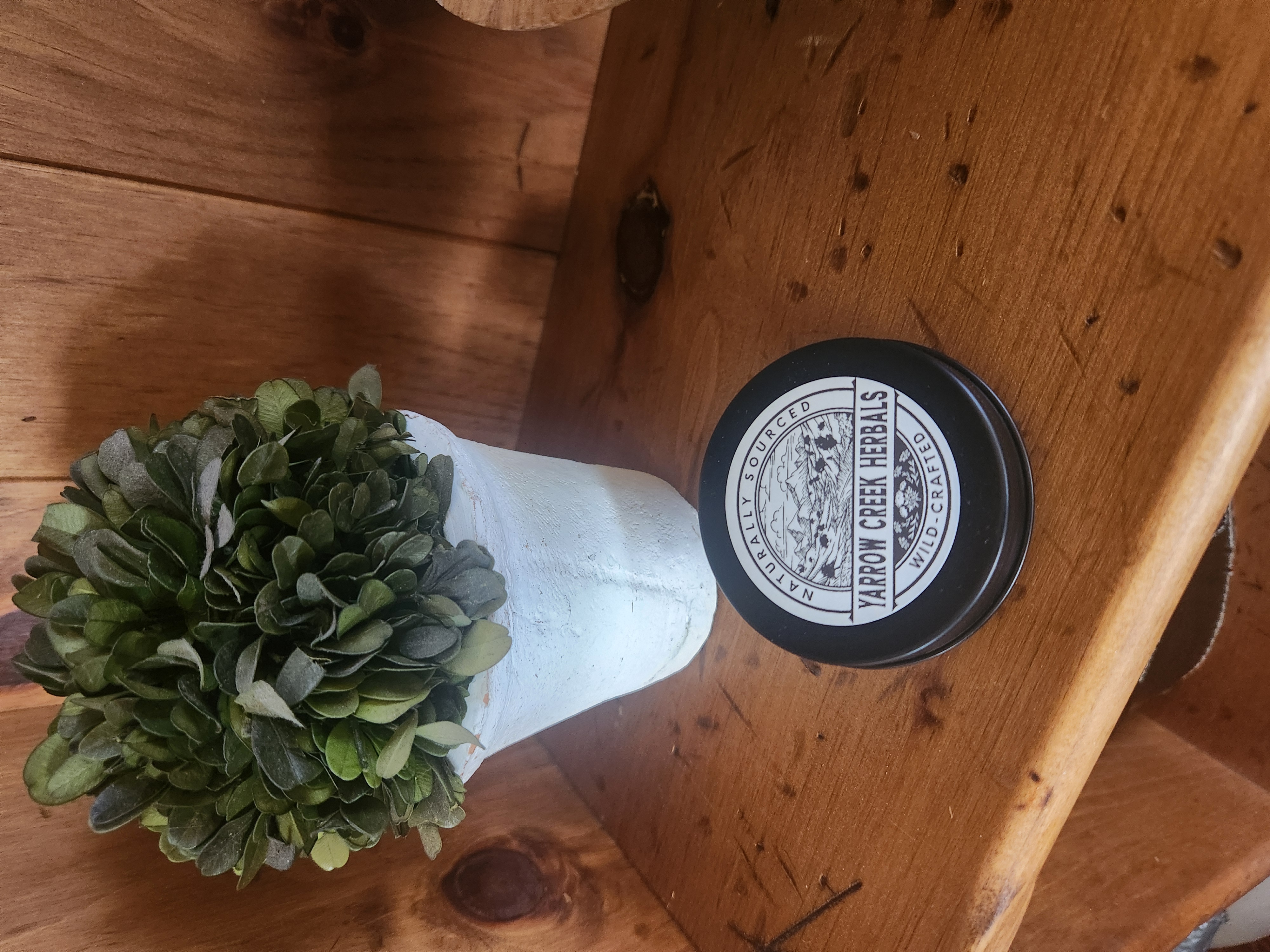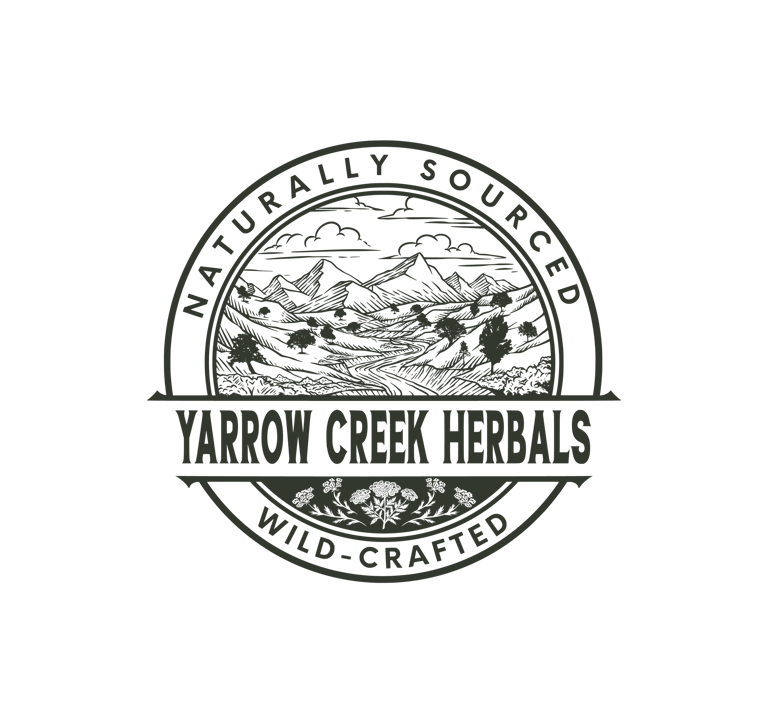
Workers Hand Balm
CA$22.00
Herbal Highlights & Research
Yarrow (Achillea millefolium)
• Yarrow oil reduced SLS-induced irritation and improved barrier recovery in a controlled human skin model.
https://pubmed.ncbi.nlm.nih.gov/28163113/
• Ethanolic extract stimulated fibroblast proliferation and enhanced scratch-wound closure in vitro.
https://pubmed.ncbi.nlm.nih.gov/26543303/
Traditional use: “Stanchweed” applied to wounds to slow bleeding and aid repair.
Calendula (Calendula officinalis)
• Faradiol esters from flowers demonstrate topical anti-inflammatory activity in animal models.
https://pubmed.ncbi.nlm.nih.gov/7809203/
• Systematic review notes signals of efficacy in wound healing and dermatitis care across small clinical trials.
https://pubmed.ncbi.nlm.nih.gov/31145533/
Traditional use: Salves and washes for burns, cracks, and inflamed skin.
Plantain (Plantago major)
• RCT: 10% P. major ointment performed comparably to silver sulfadiazine in second-degree burns.
https://pubmed.ncbi.nlm.nih.gov/35966146/
• Reviews highlight aucubin and other iridoids for anti-inflammatory and wound-healing actions.
https://pmc.ncbi.nlm.nih.gov/articles/PMC7142308/
Traditional use: “First-aid leaf” pressed onto stings, bites, and cuts to draw and soothe.
Mouse-eared Chickweed (Cerastium fontanum)
• Extracts show antioxidant (DPPH) and antibacterial activity in vitro.
https://laar.plapiqui.edu.ar/OJS/index.php/laar/article/download/547/672
• Family-level review of Caryophyllaceae documents flavonoid-driven antioxidant and soothing properties.
https://pmc.ncbi.nlm.nih.gov/articles/PMC5481791/
Traditional use: Poultices for itchy eruptions, eczema, and “hot” skin.
Nettle (Urtica dioica)
• Topical nettle extract accelerated wound closure and reduced inflammation in vivo.
https://pubmed.ncbi.nlm.nih.gov/34684829/
• In vitro, extracts protected human dermal fibroblasts from oxidative stress.
https://pmc.ncbi.nlm.nih.gov/articles/PMC10672499/
Traditional use: Spring tonic; externally for irritated, stressed skin.
Horsetail (Equisetum arvense)
• Naturally rich in silicon supporting collagen synthesis and connective-tissue strength.
https://pmc.ncbi.nlm.nih.gov/articles/PMC4938278/
• Clinical lacquer with horsetail extract improved brittle nails in adults. https://pubmed.ncbi.nlm.nih.gov/19470045/
Traditional use: For brittle nails, slow-healing wounds, and tissue strengthening.
Wild Rose (Rosa spp.)
• While the study was carried out on Rosa gallica, wild rose shares nearly identical antioxidant and anti-inflammatory compounds. Rose petal extract has been shown to reduce solar UV–induced COX-2 and pro-inflammatory cytokines in epidermal cells, helping protect and soothe skin
https://pubmed.ncbi.nlm.nih.gov/30510758/
• Research on Rosa gallica shows that rose extracts can slow pigment formation, protect collagen, and reduce wrinkle formation — benefits that support brighter, more even-toned, and firmer skin. Wild rose (Rosa spp.) contains the same families of flavonoids and antioxidants, making it a close botanical counterpart with similar effects. https://pmc.ncbi.nlm.nih.gov/articles/PMC6811464/
Traditional use: Crafted into softening balms for weathered skin, with petals and hips long used to nurture, renew, and restore vitality.
Carrier Oils & Base
Olive Oil (Olea europaea)
• RCT: extra-virgin olive oil improved hydration and reduced erythema in human skin.
https://pubmed.ncbi.nlm.nih.gov/40649050/
• Review: emolliency and antioxidant components relevant to barrier health.
https://pmc.ncbi.nlm.nih.gov/articles/PMC5796020/
Traditional use: Mediterranean anointing oil for dry, weathered skin.
Sweet Almond Oil (Prunus dulcis)
• Moisturizer with 7% almond oil improved hand dermatitis in a clinical trial. https://pubmed.ncbi.nlm.nih.gov/29320591/
• Emollient and barrier-supportive properties summarized in dermatology reviews.
https://pubmed.ncbi.nlm.nih.gov/20129403/
Traditional use: Softens and nourishes dry skin.
Coconut Oil (Cocos nucifera)
• In adults with eczema, applying virgin coconut oil daily for 4 weeks cut “staph” bacteria on the skin by 90% and made their flare-ups much less severe compared to olive oil.
https://pubmed.ncbi.nlm.nih.gov/19134433/
• In children with eczema, virgin coconut oil worked better than mineral oil for soothing irritation, locking in moisture, and healing the skin barrier after 8 weeks.
https://pubmed.ncbi.nlm.nih.gov/24320105/
Traditional use: Coconut oil has long been used across tropical cultures as a skin-softening, protective oil for dryness, irritation, and minor wounds..
Castor Oil (Ricinus communis)
• Rich in ricinoleic acid, which offers anti-inflammatory, analgesic, and antimicrobial benefits useful for soothing irritation and supporting the skin’s natural repair processes. Studies show formulations with castor oil accelerate wound healing, promote collagen formation, and help close wounds faster.
https://pubmed.ncbi.nlm.nih.gov/12874484/
• Demonstrated safety and tolerability in topical use, including on wounds and donor skin graft sites, with minimal irritation or sensitivity for most users.
https://pubmed.ncbi.nlm.nih.gov/18080873/
• In animal studies, castor oil–based formulations showed antimicrobial activity and wound-healing performance comparable to conventional antibiotic ointments.
https://www.tjnpr.org/index.php/home/article/view/4098
• Additional animal research combining castor oil with vitamin C and tragacanth gum found it accelerated collagen formation and reduced wound size.
https://www.phcog.com/article/sites/default/files/PhcogMag-16-69-359.pdf
Traditional use: Used in salves and ointments to draw out irritants, reduce discomfort, and support healing—powerful for restoring rough, callused, or weathered hands.
Beeswax (Cera alba)
• Beeswax-containing films reduce TEWL and support barrier recovery. https://pubmed.ncbi.nlm.nih.gov/28213845/
• Functions as a breathable occlusive in topical products. https://pubmed.ncbi.nlm.nih.gov/36999457/
Traditional use: Seals moisture and shields against the elements.
Hands that see real work often end up dry, cracked, and sore. Western herbal practice — now echoed in modern research — points to specific plants and oils that help mend this kind of wear. Worker’s Hand Balm pairs those traditions with a pragmatic base: beeswax and nutrient-dense oils protect the surface while carrying herbal compounds deeper, where repair begins.
The herbal lineup reflects a classic skin-repair approach. Yarrow, once packed onto battlefield wounds, offers antimicrobial and anti-inflammatory support. Calendula calms irritation and promotes tissue renewal. Plantain — the “first-aid leaf” — helps draw out stings and supports closure of small wounds. Mouse-eared chickweed cools itch. Nettle and horsetail bring minerals and silica that fortify connective tissue and collagen. Wild rose softens rough patches while contributing polyphenols and vitamin C to protect and renew.
The carriers add their own medicine: olive oil strengthens the barrier with squalene and polyphenols, sweet almond restores elasticity, coconut oil adds gentle antimicrobial support, and castor oil’s heavier cling improves penetration and staying power. Beeswax ties it together, forming a breathable seal that locks in hydration and shields against further damage.
The result is a balm that doesn’t just sit on the surface — it works with the skin to restore integrity, ease irritation, and build lasting strength in hands that labor.
How to Use
Massage a small amount into clean, dry hands or other rough areas (knuckles, elbows, heels). For intensive overnight care, apply generously and cover with cotton gloves. Use after work or whenever skin feels strained.
Ingredients
Yarrow, Calendula, Plantain, Mouse-eared Chickweed, Nettle, Horsetail, Wild Rose, Olive oil, Sweet Almond oil, Coconut oil, Castor oil, Beeswax.
Safety Note
For external use only. Discontinue if irritation occurs. Those with sensitivities to Asteraceae or Rosaceae plants should take caution.
See Disclaimer / Terms and Conditions for shelf life guidelines.
